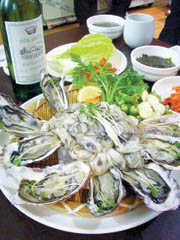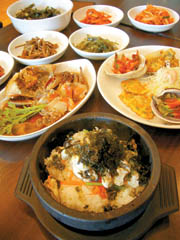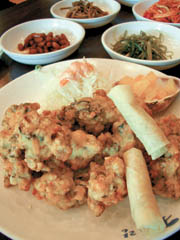Farm fresh oysters love winter’s chill

Fresh oysters and side dishes.

Traditional Korean-style abalone salad with fresh oysters and vegetables. By Ines Cho
It’s a pity most Korean restaurants don’t serve wild oysters from Korea’s western and southern coasts. Owners certainly prefer larger and cheaper farmed oysters because natural oysters “shrink like flies” when cooked, even if they taste better. Natural varieties are rare and cost more than the farmed kind. Small villages along the coast do sell natural oysters on market days, but the number of pickers and oysters have been on the decline over the years. Shoppers with keen eyes for regional varieties ― from Seosan, Goheung, Boryeong and the like ― can find them, if lucky, in seafood wholesale markets.
At half past noon, Gulsarang’s 15 tables and three private rooms were full and boisterous with local diners. The restaurant is typical Korean style, with low tables on floors and cheerful ajumma bringing food as if diners were their relatives.
Most people were having guljeongsik (an oyster set menu, 8,000 won, or about $8.50), and my lunch mate and I ordered the same. The idea of ordering gejang-jeongsik (a fresh crab set menu, 16,000 won) and gul-twigim (fried oysters, 12,000 won) as well made our mouths water.
The fried oysters were disappointing because we were imagining Japanese-style fried oysters ― fat, juicy oysters sizzling in super-crispy crusts. The Gulsarang version hid a mixture of oysters and chopped vegetables inside hot, thick batter the size of a golf ball. The set menu is a messy-looking platter of samplers ― half-shelled fresh oysters, fresh oysters mixed with red chili sauce, fried oysters, spicy oysters on skewers, a cabbage salad and chopped fruit. It comes with a large bowl of steamed rice with oysters and roasted gim (seaweed) on top. Great for first-time visitors to Gulsarang, but it won’t impress oyster connoisseurs who know the cream of the crop. When we complained to the owner, an extremely courteous Korean man at the counter, he explained that the restaurant does its best to provide taste at an affordable price.

At Gulsarang, set menus featuring fresh crab, assorted oyster samplers and steamed rice cooked with oysters are popular.
The chilled, medium-size blue crab seasoned in a soy-based sauce captured the amazing taste of clear ocean water. The fat belly oozed bright orange caviar as well as mustard, the cream of the stomach. The mild rice with plump oysters left the crab and its sauce to steal the show, and it was by far the most harmonious combination of two different sea creatures on the table.
In the evening, I invited oyster lovers who already have tried Gulsarang to another oyster restaurant called Dolkkot, located on the opposite side of town. My Korean friends said the restaurant’s name referred to the Korean word seokhwa. Seokhwa is another name for oysters in Korean. From the colorful photographs shown at the door, we figured Dolkkot served oysters as well as abalone farmed in Wando, also in the south of Korea. By 7 p.m., the restaurant was packed. We started the meal with a large plate of saenggulhoe (fresh oysters, 16,000 won) followed by gul-tangsuyuk (oysters with sweet and sour sauce, 18,000 won). Extremely friendly waitresses at first told us they had a lot of wine, but came back and said they were “sold out of many” and they “rented out wine glasses and never got them back.”

Fried oysters at Gulsarang. By Ines Cho
Jeonbok muchim (spicy abalone salad, 30,000 won), left our jubilant tongues doing the mambo. We loved the chef’s trick of hiding fresh oysters in a pile of colorful vegetables underneath a fat, chewy slab of abalone. The abalone tasted more like it came from a tank than Korea’s oceans, but a lot of spice, good texture and our party mood forgave the fact.
Stuffed with the best Dolkkot had to offer, we needed a chaser ― the very calming jeonbokjuk (abalone porridge, 12,000 won). After several spoonfuls of the wonderfully soothing, pale-green porridge, which promises eternal health according to a Korean saying, I decided that whether the abalone came from a tank or from the bluest ocean was less important than the fact that I was enjoying it at the moment.
Gulsarang
English: Not spoken, not on the menu.
Tel: (02) 425-1221
Web: www.iloveoyster.com
Hours: 11:30 a.m.-10 p.m. daily
Location: Near Seokchon Lake in Songpa district
Parking: Available
Dress code: Come as you are
Dolkkot
English: Not spoken, not on the menu.
Tel: (02) 324-5894
Web: www.seaflower.co.kr
Hours: 11 a.m.-10:30 p.m. daily
Location: Near T.G.I. Friday’s in the Hongdae area
Parking: Available
Dress code: Come as you are
By Ines cho Staff Writer [inescho@joongang.co.kr]










with the Korea JoongAng Daily
To write comments, please log in to one of the accounts.
Standards Board Policy (0/250자)